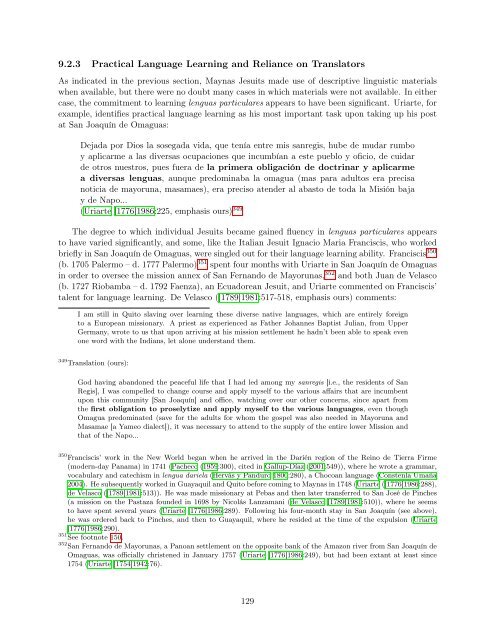draft manuscript - Linguistics - University of California, Berkeley
draft manuscript - Linguistics - University of California, Berkeley
draft manuscript - Linguistics - University of California, Berkeley
You also want an ePaper? Increase the reach of your titles
YUMPU automatically turns print PDFs into web optimized ePapers that Google loves.
9.2.3 Practical Language Learning and Reliance on Translators<br />
As indicated in the previous section, Maynas Jesuits made use <strong>of</strong> descriptive linguistic materials<br />
when available, but there were no doubt many cases in which materials were not available. In either<br />
case, the commitment to learning lenguas particulares appears to have been significant. Uriarte, for<br />
example, identifies practical language learning as his most important task upon taking up his post<br />
at San Joaquín de Omaguas:<br />
Dejada por Dios la sosegada vida, que tenía entre mis sanregis, hube de mudar rumbo<br />
y aplicarme a las diversas ocupaciones que incumbían a este pueblo y <strong>of</strong>icio, de cuidar<br />
de otros nuestros, pues fuera de la primera obligación de doctrinar y aplicarme<br />
a diversas lenguas, aunque predominaba la omagua (mas para adultos era precisa<br />
noticia de mayoruna, masamaes), era preciso atender al abasto de toda la Misión baja<br />
y de Napo...<br />
(Uriarte [1776]1986:225, emphasis ours) 349<br />
The degree to which individual Jesuits became gained fluency in lenguas particulares appears<br />
to have varied significantly, and some, like the Italian Jesuit Ignacio Maria Franciscis, who worked<br />
briefly in San Joaquín de Omaguas, were singled out for their language learning ability. Franciscis 350<br />
(b. 1705 Palermo – d. 1777 Palermo) 351 spent four months with Uriarte in San Joaquín de Omaguas<br />
in order to oversee the mission annex <strong>of</strong> San Fernando de Mayorunas, 352 and both Juan de Velasco<br />
(b. 1727 Riobamba – d. 1792 Faenza), an Ecuadorean Jesuit, and Uriarte commented on Franciscis’<br />
talent for language learning. De Velasco ([1789]1981:517-518, emphasis ours) comments:<br />
I am still in Quito slaving over learning these diverse native languages, which are entirely foreign<br />
to a European missionary. A priest as experienced as Father Johannes Baptist Julian, from Upper<br />
Germany, wrote to us that upon arriving at his mission settlement he hadn’t been able to speak even<br />
one word with the Indians, let alone understand them.<br />
349 Translation (ours):<br />
God having abandoned the peaceful life that I had led among my sanregis [i.e., the residents <strong>of</strong> San<br />
Regis], I was compelled to change course and apply myself to the various affairs that are incumbent<br />
upon this community [San Joaquín] and <strong>of</strong>fice, watching over our other concerns, since apart from<br />
the first obligation to proselytize and apply myself to the various languages, even though<br />
Omagua predominated (save for the adults for whom the gospel was also needed in Mayoruna and<br />
Masamae [a Yameo dialect]), it was necessary to attend to the supply <strong>of</strong> the entire lower Mission and<br />
that <strong>of</strong> the Napo...<br />
350 Franciscis’ work in the New World began when he arrived in the Darién region <strong>of</strong> the Reino de Tierra Firme<br />
(modern-day Panama) in 1741 (Pacheco (1959:300), cited in Gallup-Díaz (2001:549)), where he wrote a grammar,<br />
vocabulary and catechism in lengua dariela (Hervás y Panduro 1800:280), a Chocoan language (Constenla Umaña<br />
2004). He subsequently worked in Guayaquil and Quito before coming to Maynas in 1748 (Uriarte ([1776]1986:288),<br />
de Velasco ([1789]1981:513)). He was made missionary at Pebas and then later transferred to San José de Pinches<br />
(a mission on the Pastaza founded in 1698 by Nicolás Lanzamani (de Velasco [1789]1981:510)), where he seems<br />
to have spent several years (Uriarte [1776]1986:289). Following his four-month stay in San Joaquín (see above),<br />
he was ordered back to Pinches, and then to Guayaquil, where he resided at the time <strong>of</strong> the expulsion (Uriarte<br />
[1776]1986:290).<br />
351 See footnote 150.<br />
352 San Fernando de Mayorunas, a Panoan settlement on the opposite bank <strong>of</strong> the Amazon river from San Joaquín de<br />
Omaguas, was <strong>of</strong>ficially christened in January 1757 (Uriarte [1776]1986:249), but had been extant at least since<br />
1754 (Uriarte [1754]1942:76).<br />
129
















